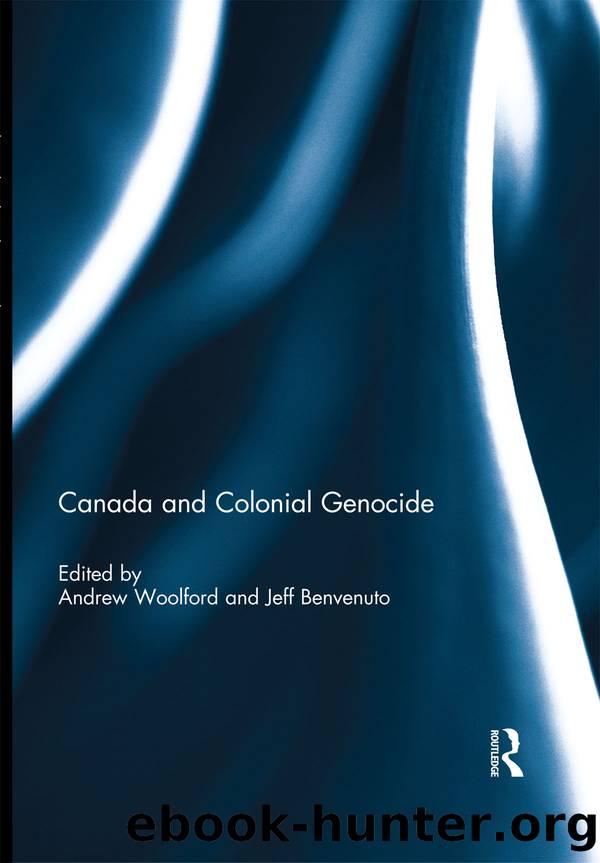Canada and Colonial Genocide by Andrew Woolford & Jeff Benvenuto

Author:Andrew Woolford & Jeff Benvenuto [Woolford, Andrew & Benvenuto, Jeff]
Language: eng
Format: epub
ISBN: 9781138224766
Google: IxLEjwEACAAJ
Goodreads: 33573994
Publisher: Routledge
Published: 2016-12-13T00:00:00+00:00
The Métis
Métis people have unique languages, communities and social organizations. Often living on the perpetual margins and Canadaâs true periphery, the Métis in Canada inhabit a space that is neither fully Indian nor fully âwhiteâ. In communities, or alongside Indian reserves and Euro-Canadian towns, especially during the first half of the twentieth century, Métis posed a different kind of âproblemâ to the Dominion.19 Back and forth across provincial and federal boundaries, the control and manipulation of the Métis was never administered consistently, but was declared an ongoing, lingering âproblemâ by federal and provincial authorities in Canada.20 These inconsistencies also contributed to the invisibility of Métis histories that are lost in a debate over naming and identity.21 Rudimentary beginnings to the Métis nations in Canada started in communities involved in the fur trade system in the sixteenth and seventeenth centuries, as European men had children with First Nations women. Large, often encapsulated communities of Métis arose from these unions, and from these communities grew distinct social, political and economic orders, as well as an original Indigenous language and a distinct land base.22 Métis communities grew across Canada, but it is in Canadaâs West that Métis political economy became both a prominent aid and a barrier to the creation of Canada. Métis emerged as powerful intermediaries between European settlers and First Nations and as an independent set of nations, whose role as traders and entrepreneurs fuelled North American trade and a new West in Canada. Métis spirituality, religion, language, laws and community structure were unique from First Nations and Europeans, but they also shared characteristics. Take, for example, Michif, which integrates a mixture of French nouns with typically Cree or Ojibway verbs into a unique language. As a metaphor for the Métis themselves, Michif is a language that is used among Métis people, though it is occasionally mistaken for an intermediary language only for speaking with French or Cree speakers. It is a separate language developed beyond what would be considered a pidgin language.23 Métis bridged between colonizer and the colonized but were more than just intermediaries. They are a nation with unique, Indigenous origins and are more than the sum of their blood quantum.24
Métis nations and leaders in Canada were cast as both treasonous and rebellious through the end of the nineteenth century and into the twentieth century. After their removal and dispossession they became marginalized, destitute and largely forgotten.25 Several decades passed before Métis were given ample and free opportunity to self-define and legally determine their own collective and individual identities.26 In contrast to First Nations communities in Canada, Métis are consistently asked to define and redefine their identity and the parameters of their communities. There are undoubtedly grey areas for individuals who over their lifetime have been considered Métis, Non-Status, non-Indigenous or Halfbreed. Changes in legislation, the Indian Act in particular, meant that a single person could be considered under the law an Indian, a Métis and then an Indian again over the course of his or her lifetime.27
Download
This site does not store any files on its server. We only index and link to content provided by other sites. Please contact the content providers to delete copyright contents if any and email us, we'll remove relevant links or contents immediately.
| 19th Century | 20th Century |
| Exploration | First Nations |
| Founding | Pre-Confederation |
| Province & Local | War of 1812 |
Cat's cradle by Kurt Vonnegut(15262)
Pimp by Iceberg Slim(14438)
4 3 2 1: A Novel by Paul Auster(12333)
Underground: A Human History of the Worlds Beneath Our Feet by Will Hunt(12054)
The Radium Girls by Kate Moore(11977)
Wiseguy by Nicholas Pileggi(5711)
The Fire Next Time by James Baldwin(5386)
Perfect Rhythm by Jae(5359)
American History Stories, Volume III (Yesterday's Classics) by Pratt Mara L(5276)
Paper Towns by Green John(5141)
Pale Blue Dot by Carl Sagan(4960)
A Higher Loyalty: Truth, Lies, and Leadership by James Comey(4909)
The Mayflower and the Pilgrims' New World by Nathaniel Philbrick(4463)
The Doomsday Machine by Daniel Ellsberg(4452)
Killers of the Flower Moon: The Osage Murders and the Birth of the FBI by David Grann(4410)
The Sympathizer by Viet Thanh Nguyen(4344)
Too Much and Not the Mood by Durga Chew-Bose(4305)
The Borden Murders by Sarah Miller(4278)
Sticky Fingers by Joe Hagan(4148)
